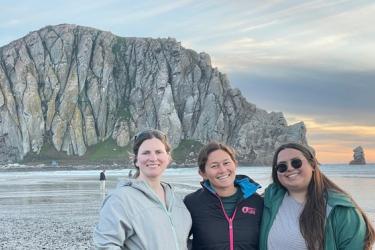This unassuming tube might not look very glamorous but they have found themselves at the center of attention aboard the R/V Bell M. Shimada. This is a pyrosome, specifically Pyrosoma atlanticum, the common species in the NE Pacific (Fig. 1). Pyrosomes are pelagic Tunicates, which are part of Chordata, a phylum that includes humans. It is tough and slimy to the touch with small, pronounced bumps. Inside the wall of this gelatinous tube, which can get up to 60 cm, individual zooids are tightly packed together. These zooids have an incurrent and excurrent siphon and use cilia to pump water for feeding, respiration and movement (Fig. 2). Using a mucus net, they filter water for small planktonic microorganisms. Pyrosomes are known to aggregate in large clusters at the surface and the zooids bioluminesce to create beautiful light displays. All of this together would make for a spectacular sight underwater.
As bizarre as they may seem, these animals are not uncommon to those sampling off Oregon. But on our recent trip aboard the Bell M. Shimada, pyrosomes seem to be everywhere! We have been getting numerous specimens in our three different sampling gears: vertical net, Bongo net, and Beam trawl. At one of our nearshore stations, the Beam trawl brought up 2.5 gallons of pyrosomes (Fig. 3)! We were also lucky to encounter a large aggregation at the surface on the Newport Line transect. This anomalous abundance of pyrosomes has been observed in other research cruises along the West coast. A long-term time series in the California Current saw the highest catches ever of Pyrosoma atlanticum in 2015. Pyrosomes have been mystifying beachcombers up and down the coast as they wash up on beaches. These gelatinous organisms join a list of other gelatinous zooplankton, such as Aequorea spp., Doliolids, and the pteropod Corolla spectabilis, that have been seen in large numbers over the past few years.
As with many gelatinous zooplankton, we lack crucial insights into their natural history. So it can be difficult to tease apart how they may be impacting marine ecosystems. For instance, pyrosomes can grow rapidly and are efficient filterers with the potential to have a significant impact on phytoplankton blooms. For now, our current observations maintain that recent oceanic conditions are ideal for pyrosome populations. I’m guaranteeing this isn’t the last you’ve heard of Pyrosoma atlanticum. Stay tuned!




